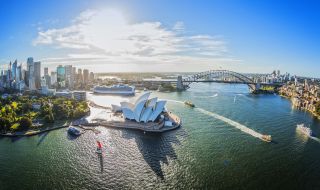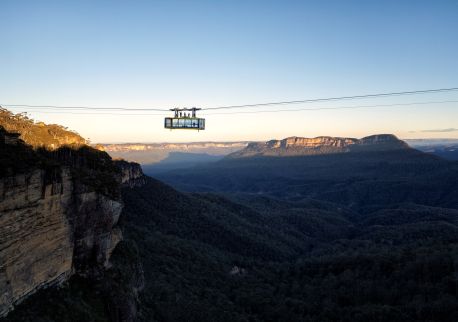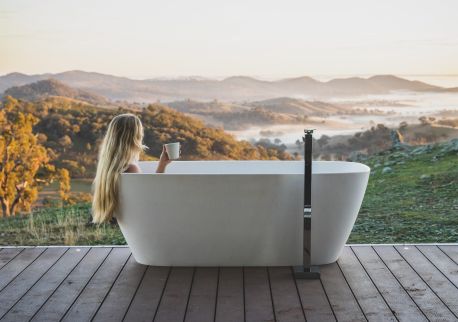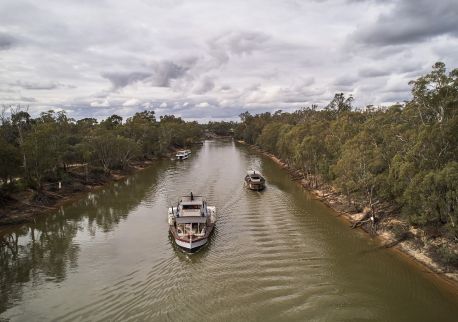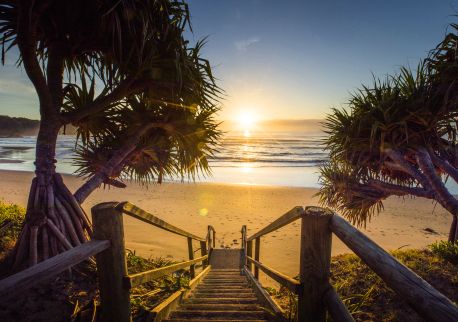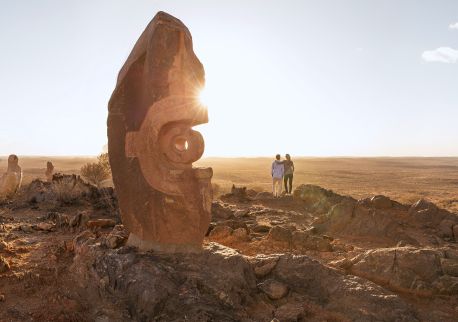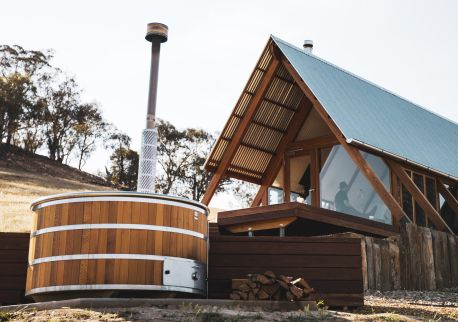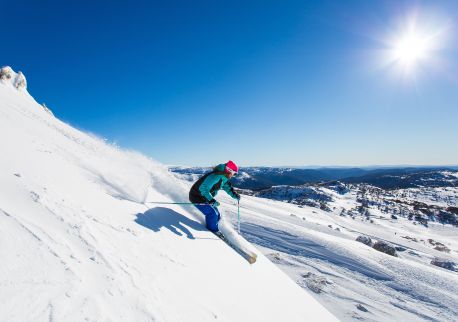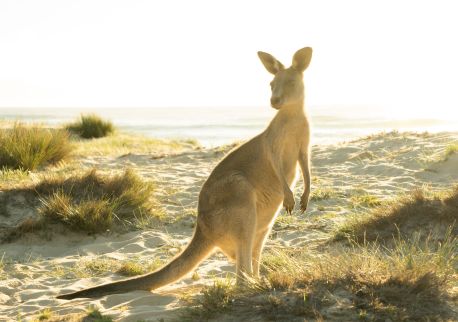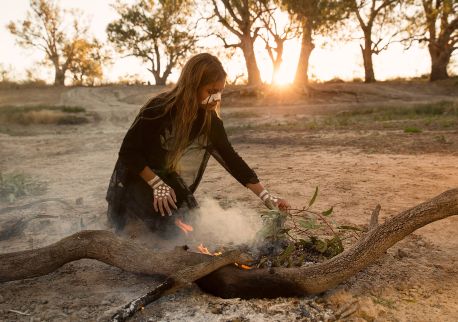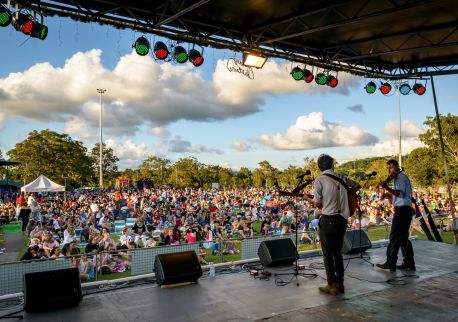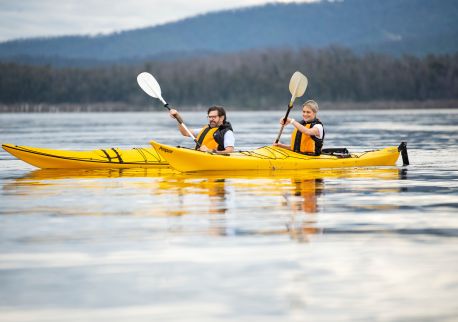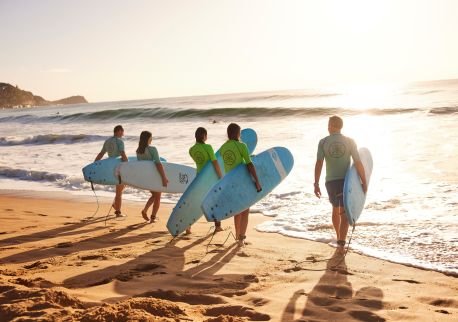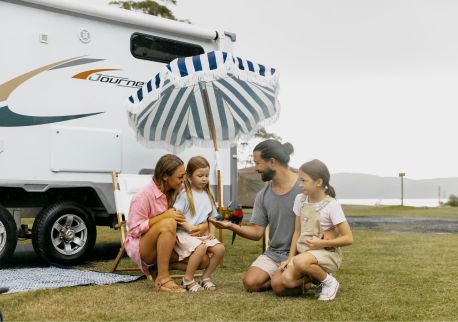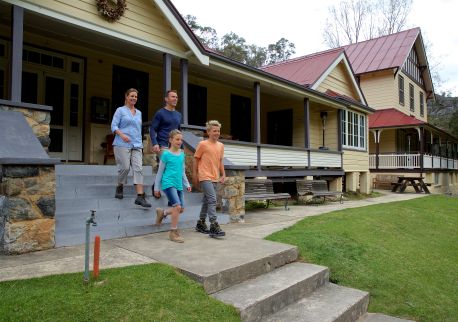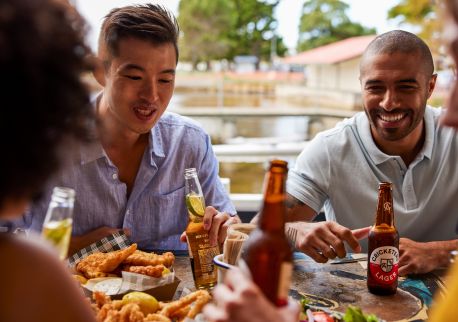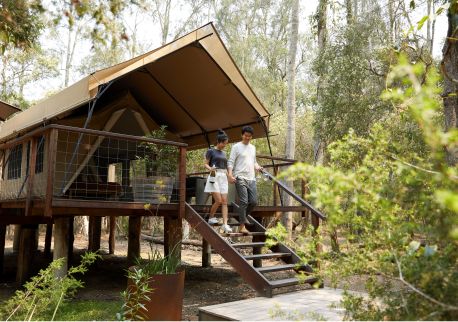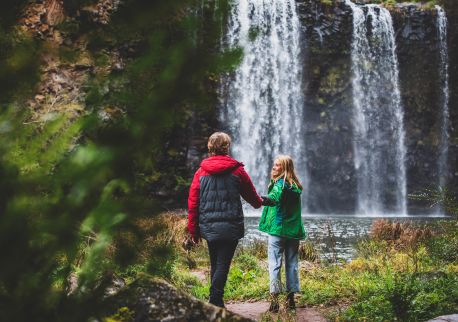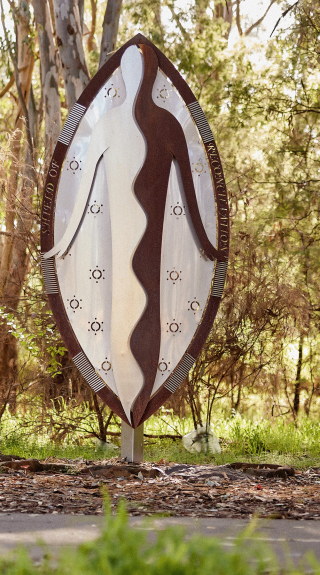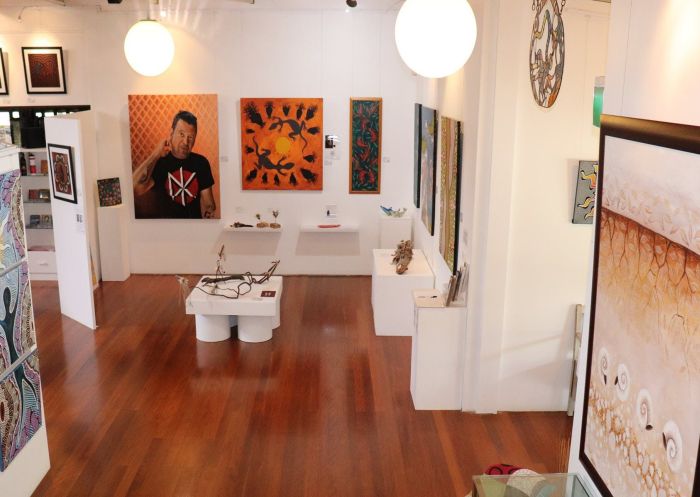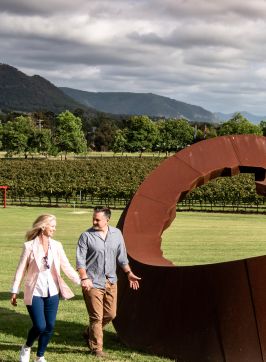Discover the rich diversity of Aboriginal art at cultural centres and major regional galleries across NSW. Paintings, sculptures, woven creations and gallery tours await.
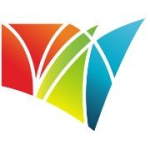
Destination NSW
- 5 min read
Murray Art Museum Albury (MAMA)
In Albury, on the NSW/Victorian border, the relatively new MAMA holds more than 2,400 works, with a strong emphasis on contemporary photography. Among the 600-plus photographs are works from Destiny Deacon and several series by revered photographer and filmmaker Tracey Moffatt.
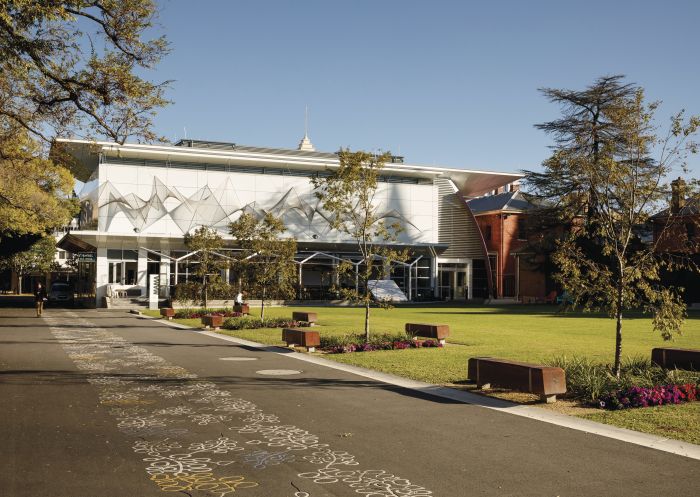
Murray Art Museum Albury (MAMA), Albury
Broken Hill Regional Art Gallery
Housed in a historic emporium on the Silver City’s main drag, Argent Street, Broken Hill Regional Art Gallery is NSW’s oldest regional gallery. Its collection of contemporary Aboriginal art includes works by Far West NSW artists Badger Bates and Edith Kennedy. The holding also includes Clifford Possum Tjapaltjarri, a desert stockman who became the most celebrated Aboriginal artist of his generation; Emily Kame Kngwarreye, who produced more than 3,000 artworks during an eight-year painting career; and revered Yolngu bark painter David Malangi.
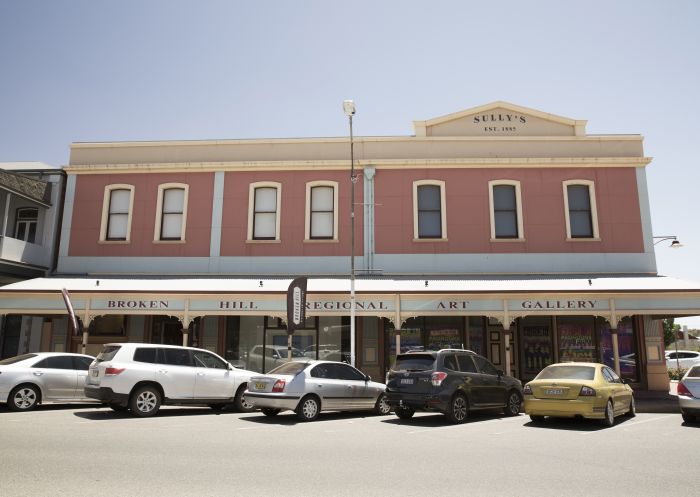
Broken Hill Regional Art Gallery, Broken Hill
Wadjar Regional Indigenous Gallery
At Corindi Beach north of Woolgoolga on the mid-North Coast is the Yarrawarra Aboriginal Cultural Centre. Step inside and look around the Wadjar Regional Indigenous Gallery, which exhibits works from First Nations artists from regional NSW. You can also see artefacts that illuminate thousands of years of Gumbaynggirr life on this part of the NSW coast at the Jalumbo Cultural Heritage Keeping Place. Head to the Pipeclay Cafe for a meal using native ingredients (think salad wraps with warrigal greens, 'roo burgers, and scones with dollops of Davidson plum jam and cream). The centre also hosts a monthly weaving circle.
Museum of Art and Culture, yapang
In Lake Macquarie, a 90-minute drive north of Sydney, visit the Museum of Art and Culture – commonly known as MAC. The museum’s collection includes yapang – a sub-collection of Aboriginal works on paper. Among the collected artists are Sydney-based Jonathan Jones and Jason Wing, Judy Watson, Ruby Djikarra Alderton, Eubena Nampitjin, Ningie Nangala, Kathleen Paddoon and Freddie Timms.

Museum of Art and Culture, yapang (MAC), Lake Macquarie
Bank Art Museum Moree (BAMM)
Head to Moree, a lively artesian-spa town on the black-soil plains of northern NSW, for incredible art experiences. Bank Art Museum Moree (BAMM) occupies a striking Edwardian-style corner building in the town’s centre. It’s renowned for its Aboriginal art collection, one of the most significant in regional NSW.
Keep exploring: See more Aboriginal artworks at Yaama Ganu Gallery on Balo Street. Inspect exhibited works, ask to see what’s in the stockroom and relax afterwards in the adjoining cafe.

Couple discussing art works, Bank Art Museum (BAMM), Moree
Armidale Aboriginal Cultural Centre
The Armidale Aboriginal Cultural Centre showcases Aboriginal art and crafts which are for sale. Visitors can join guided gallery tours, participate in cultural workshops like weaving and jewellery-making, and fuel up at the Echidna Cafe.

Armidale and Region Aboriginal Cultural Centre and Keeping Place, Armidale - Credit: David Doyle
Wollongong Art Gallery
Among the almost 3,000 works in the Wollongong Art Gallery are Indigenous paintings, screen-prints, photographs, carvings, hunting artefacts, dancing sticks, bark paintings and didgeridoos. NSW artists Michael Riley, Harry Wedge, Ruby O Shelton and Jayson Buddle are all represented in the collection.

Wollongong Art Gallery, Wollongong - Credit: Wollongong Art Gallery
Yindyamarra Sculpture Walk
Set along the banks of the Murray River in Albury, the 5km Yindyamarra Sculpture Walk features 15 striking contemporary sculptures by Aboriginal artists. Each artwork has an interpretive sign that explains their meaning from Michael Quinn’s work that explores the family unity and Indigenous connection to the land to Ruth Davys’ installation that illustrates the bogon moth migration and how Aboriginal communities would feast on these winged delicacies.
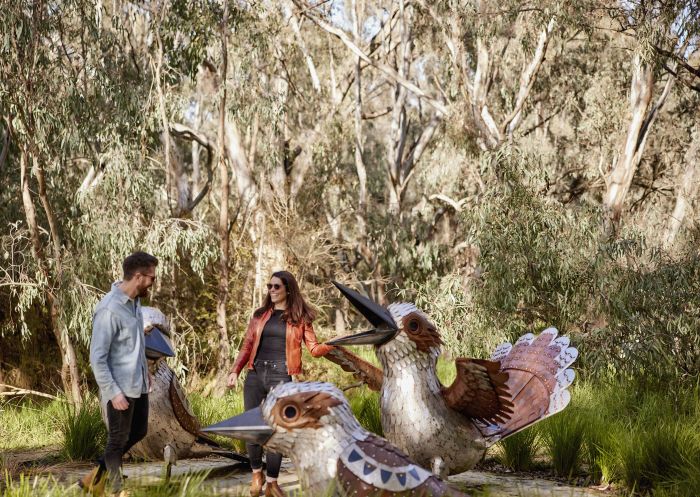
Wagirra Trail and Yindyamarra Sculpture Walk, Albury Wodonga
Dunghutti-Ngaku Aboriginal Art Gallery
Located in Kempsey, the Dunghutti-Ngaku Aboriginal Art Gallery showcases powerful works by established and emerging Aboriginal artists from the North Coast. Housed in a building designed by renowned architect Glenn Murcutt, the gallery features a rotating program of exhibitions and a permanent collection rich in cultural storytelling. Visitors can also browse a curated gift shop offering authentic art, jewellery and textiles.
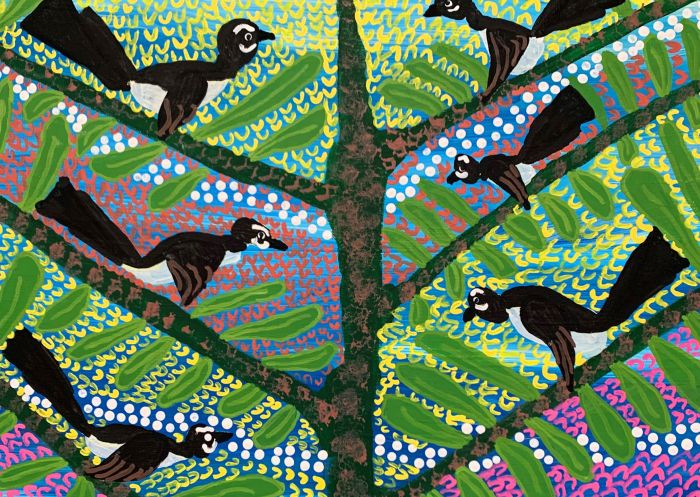
Dunghutti-Ngaku Aboriginal Art Gallery, South Kempsey - Credit: Alan Guihot
Beyond the galleries: Discover ancient rock art
For millennia, NSW’s Aboriginal communities told their stories via drawings, paintings and petroglyphs on rocks. Remarkably, much of it remains today. Visit Mutawintji National Park, northeast of Broken Hill, to see hand stencils, a Groonki mark (stick figures said to symbolise a spiritually significant site), and a painting of a Yarra stick. Interpretive signs explain the details. Meanwhile in Gundabooka National Park near Bourke, jaw-dropping Aboriginal rock paintings depict animals, dancers, hand stencils and hunting tools. A number of Aboriginal-owned and -operated companies offer tours that interpret rock art, as well as the Aboriginal connection to the land and wildlife. Discover beautiful rock carvings in Bouddi National Park with Girri Girra Aboriginal Experiences. Visit cultural sites in and around Yengo National Park on a tour with Wollombi Aboriginal Cultural Experiences. Or see and learn about Red Hands Cave in Ku-ring-gai Chase National Park with Guringai Tours.

Mutawintji National Park, Mutawintji
